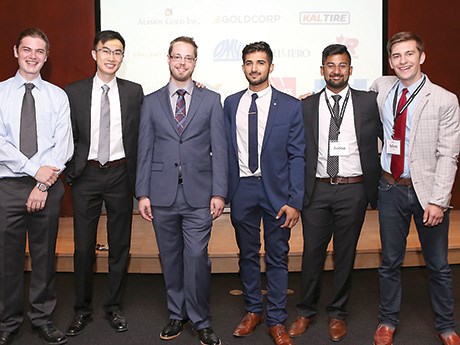Laurentian University teams clean up
Two Laurentian University teams took top honours in the Ontario Mining Association’s inaugural MINED Open Invitation Challenge.
Undergraduate students from the University of Toronto’s Lassonde Institute of Mining, Queen’s University’s Robert M. Buchan Department of Mining and Laurentian’s Bharti School of Engineering were provided with a case study of a fictional mine and invited to come up with a innovative, cost-efficient ventilation solution for a planned expansion at depth.
The three finalists – two teams from Laurentian and one from the University of Toronto – squared off at a Dragon’s Den-like event June 14th at the Hockey Hall of Fame in Toronto.
The winning Pipe Dreams team, made up of Joshua Fortes, Alex MacInnes, Adam Grinbergs, Liam Dunn, Muhammad Syed and Justin So – all fourth year mining engineering students – proposed piping cold water from a lake to cool the new zones at depth. The water would descend through boreholes to spray chambers where it would cool air from the ventilation system. The water would then be pumped back to surface and returned to the lake.
“The case study indicated that the mine was near a deep fresh water lake, so we thought we would use this idea because it was so simple,” said team spokesman Joshua Fortes. “All we had to do was find a way to bring the water down and pump it back up economically.”
The Pipe Dreams team estimated they would need 3,300 gallons of water per minute, which works out to only one per cent of the lake’s water per year, taking Windy Lake in Sudbury as an example.
Towards the end of the project, the team learned about Enwave Energy Corp.’s deep lake water cooling system in downtown Toronto, adding credibility to their idea. The Enwave solution, in operation since August 2004, pipes water from the depths of Lake Ontario five kilometres from shore to cool approximately 30 buildings in the city’s financial district.
Using cold lake water to cool the new zones at depth would be considerably less expensive than conventional solutions, said Fortes. A cooling tower, for example, would require very large excavations and consume significantly more power.
The Pipe Dreams proposal didn’t consider the possibility of using the force of the falling water to generate electricity, but the team was aware of a mine in South Africa that employs a Pelton wheel to do just that. Adding this technology to the cooling system would wipe out the costs associated with pumping the water to surface and back to the lake, noted Fortes.
The proposal included the cost of a water treatment plant on surface, recognizing that cottagers and other users of the lake would have concerns about water quality but, according to Fortes, a water treatment plant wouldn’t really be necessary.
“It’s an isolated system that doesn’t interact with the mine water. It’s only interacting with fresh air from the ventilation system.”
The Pipe Dreams team won the first place prize of $15,000.
The Next Phase team from Laurentian consisting of Sarah Bulanda, Peter Gazaes and Patrick Lamontagne, proposed lining the walls of the mine’s downcast shaft with phase change material in microcapsules embedded in a cement mortar.
Phase change material is a wax that absorbs heat during the day and releases it at night, explained team spokesperson Sarah Bulanda. “It’s a lot more popular in Europe, where it’s used in office buildings.”
The team estimated it would need 200,000 kilograms of wax for the 1,500-metre shaft.
The decrease in temperature at the 1,500-metre level would be 3.5 degrees Celsius in May and 5 degrees Celsius in July, said Bulanda.
“The 5 degree temperature change would be equivalent to the cooling power of a 5.7 megawatt cooling station, so if you can get that degree of cooling without incurring any operating costs, that’s pretty significant.”
The Next Phase team won the second place prize of $10,000 as well as the $5,000 audience choice prize.
Finishing in third place was the University of Toronto’s Safe Through Sound team for its acoustic agglomeration solution.
Team members Yoko Yanagimura, Marina Reny, Matt Hart and Justin Samardzic came up with the novel idea of using acoustic agglomeration to increase the size of the particles in diesel emissions.
With new diesel technology, particle sizes are getting smaller and smaller, less amenable to filtration and more dangerous to human health, explained team spokesman Matt Hart. By bombarding ventilation air with acoustic emissions at an ultrasound frequency, the particles agglomerate and can be captured more easily through electrostatic precipitators or bag houses.
Once the air is filtered, the Safe Through Sound team proposes recirculating it.
“The total resistance that the airflow must overcome in order to recirculate at lower horizons is much less than the total mine resistance that the airflow must overcome moving from surface intake raise to the surface return air raise. By recirculating some of the filtered air, we minimize the total resistance that the airflow must overcome,” claims the U of T team. “This should result in some power cost savings.”
The Safe Through Sound team took home the third place prize of $5,000, but the value of the competition went far beyond the monetary prizes.
As Sarah Bulanda of the Next Phase team remarked, “The networking experience after the presentations was invaluable and that alone made the event worthwhile. Not only was the competition able to showcase up-and-coming students, but it also showed the mining community that there is room for innovation and that there are people ready and willing to try.”
Judges for the competition included Vale CEO Jennifer Maki, Kirkland Lake Gold president and CEO Tony Makuch and Goldcorp CFO Steve Thomas. Members of the OMA’s expert panel responsible for planning the competition included Peter Larsen of KalTire, Peter Fuchs of Glencore, Gilbert Lamarche of Vale, Zach Mayer of Glencore – Kidd Creek, John Mullally of Goldcorp and Phil Ng of Wesdome.



